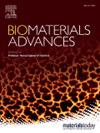纳米片状WS2/ICG纳米复合材料在感染性伤口的光动力/光热协同细菌清除和皮肤再生。
IF 6
2区 医学
Q2 MATERIALS SCIENCE, BIOMATERIALS
Materials Science & Engineering C-Materials for Biological Applications
Pub Date : 2025-01-16
DOI:10.1016/j.bioadv.2025.214192
引用次数: 0
摘要
细菌感染对人类健康构成重大威胁,新型抗生素开发速度缓慢和细菌耐药性的迅速出现加剧了这一挑战。新型抗菌剂的开发至关重要。吲哚菁绿(ICG)是一种广泛应用的成像染料,它能有效地产生活性氧(ROS)和热,用于治疗细菌感染,但其聚集性和不稳定性限制了其疗效。在这项研究中,使用具有高表面积的二硫化钨(WS₂)纳米片负载ICG,创建多功能纳米复合材料WS2/ICG,旨在治疗细菌感染的伤口。WS₂的二维表面结构为ICG提供了可分散的结合位点,合成的纳米复合材料具有优异的稳定性。在近红外(NIR)激光激发下,产生的热量进一步协同提高了单线态氧的产率。此外,WS₂/ICG纳米平台将光热效应和光动力效应协同结合,实现了“1 + 1 > 2”增强。在近红外激光激发下,纳米复合材料通过局部加热和ROS积累破坏细菌细胞膜,导致能量代谢系统中断,导致细菌裂解和死亡。研究结果表明,WS₂/ICG具有出色的抗菌性能和生物相容性,可有效治疗皮肤感染并促进组织再生,为细菌感染伤口提供了一种简单而有前景的解决方案。本文章由计算机程序翻译,如有差异,请以英文原文为准。
Nanosheet-shaped WS2/ICG nanocomposite for photodynamic/photothermal synergistic bacterial clearance and cutaneous regeneration on infectious wounds
Bacterial infections present a significant threat to human health, a challenge that is intensified by the slow pace of novel antibiotic development and the swift emergence of bacterial resistance. The development of novel antibacterial agents is crucial. Indocyanine green (ICG), a widely used imaging dye, efficiently generates reactive oxygen species (ROS) and heat for treating bacterial infections but suffers from aggregation and instability, limiting its efficacy. In this study, tungsten disulfide (WS₂) nanosheet with a high surface area was used to load ICG, creating a multifunctional nanocomposite, WS2/ICG, aimed at treating bacteria-infected wounds. The two-dimensional surface structure of WS₂ provides dispersible binding sites for ICG, and the synthesized nanocomposite exhibits excellent stability. Under near-infrared (NIR) laser excitation, the generated heat further synergistically enhances the yield of singlet oxygen. Additionally, the WS₂/ICG nanoplatform synergistically combines photothermal effect with photodynamic effect, achieving a “1 + 1 > 2” enhancement. Upon NIR laser excitation, the nanocomposite disrupts bacterial cell membranes through localized heating and ROS accumulation, leading to energy metabolism system disruption and subsequent bacterial lysis and death. The findings demonstrate WS₂/ICG's outstanding antibacterial properties and biocompatibility, effectively treating skin infections and promoting tissue regeneration, providing a simple and promising solution for bacteria-infected wounds.
求助全文
通过发布文献求助,成功后即可免费获取论文全文。
去求助
来源期刊
CiteScore
17.80
自引率
0.00%
发文量
501
审稿时长
27 days
期刊介绍:
Biomaterials Advances, previously known as Materials Science and Engineering: C-Materials for Biological Applications (P-ISSN: 0928-4931, E-ISSN: 1873-0191). Includes topics at the interface of the biomedical sciences and materials engineering. These topics include:
• Bioinspired and biomimetic materials for medical applications
• Materials of biological origin for medical applications
• Materials for "active" medical applications
• Self-assembling and self-healing materials for medical applications
• "Smart" (i.e., stimulus-response) materials for medical applications
• Ceramic, metallic, polymeric, and composite materials for medical applications
• Materials for in vivo sensing
• Materials for in vivo imaging
• Materials for delivery of pharmacologic agents and vaccines
• Novel approaches for characterizing and modeling materials for medical applications
Manuscripts on biological topics without a materials science component, or manuscripts on materials science without biological applications, will not be considered for publication in Materials Science and Engineering C. New submissions are first assessed for language, scope and originality (plagiarism check) and can be desk rejected before review if they need English language improvements, are out of scope or present excessive duplication with published sources.
Biomaterials Advances sits within Elsevier''s biomaterials science portfolio alongside Biomaterials, Materials Today Bio and Biomaterials and Biosystems. As part of the broader Materials Today family, Biomaterials Advances offers authors rigorous peer review, rapid decisions, and high visibility. We look forward to receiving your submissions!

 求助内容:
求助内容: 应助结果提醒方式:
应助结果提醒方式:


